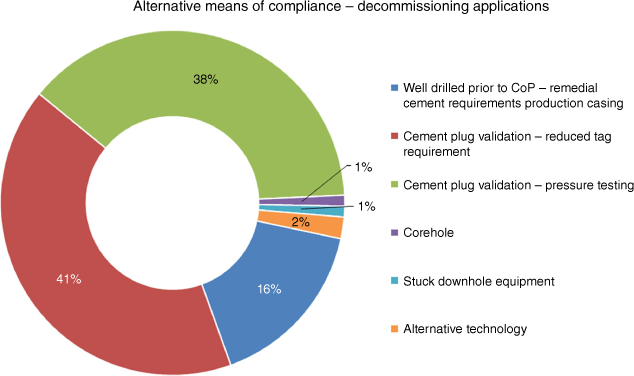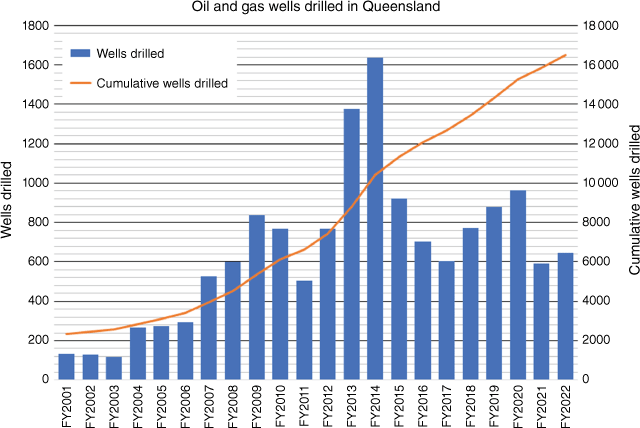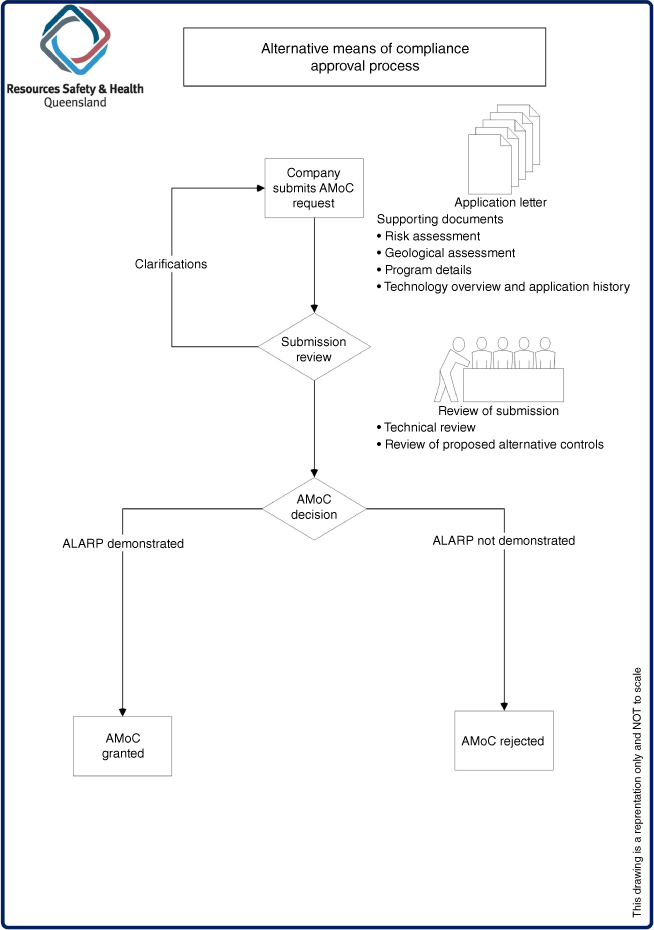Decoding decommissioning requirements when using new technology – Queensland’s petroleum wells code of practice
Chris Barrand A * and Radika Lucas AA Resources Safety and Health Queensland, Petroleum Gas Inspectorate, Brisbane, Qld, Australia.
The APPEA Journal 63 S291-S295 https://doi.org/10.1071/AJ22151
Accepted: 6 March 2023 Published: 11 May 2023
© 2023 The Author(s) (or their employer(s)). Published by CSIRO Publishing on behalf of APPEA. This is an open access article distributed under the Creative Commons Attribution-NonCommercial-NoDerivatives 4.0 International License (CC BY-NC-ND)
Abstract
Resources Safety and Health Queensland (RSHQ) is the independent regulator for safety and health in Queensland’s resources sector. The Petroleum and Gas Inspectorate administers safety and health regulation for the petroleum and gas industry. RSHQ uses a risk-based and data-driven approach to pursue its vision of zero serious harm for resource sector workers. The Code of practice for the construction and abandonment of petroleum wells and associated bores in Queensland (the Code) was introduced in 2011 to manage the expansion of well construction activities associated with the emerging coal seam gas (CSG) industry. The statutory application of the Code under the former Petroleum and Gas (Production and Safety) Regulation 2004 commenced 1 January 2012. Since implementation, the Code has been regularly revised with a single code adopted in 2018 for both CSG and petroleum wells. The Code is applied under sections 35 and 36 of the Petroleum and Gas (Safety) Regulation 2018. The Code directly addresses the highest level of controls in risk management of the identified high-risk areas for the construction, maintenance and decommissioning of petroleum and water bores. The Code permits alternative means of compliance (AMoC) against the stated means of compliance. Since commencement of the Code, approximately 87% of AMoC applications received by the Chief Inspector are related to well decommissioning activities. This paper evaluates the AMoC process under the Code, and considers its application and the regulatory challenges faced by Queensland operators during decommissioning of wells. The paper’s objective is to highlight the application of the AMoC process and identify potential areas for improvement to facilitate the adoption of new decommissioning technologies.
Keywords: code of practice, decommissioning, plug and abandonment, regulatory, technology readiness level, TRA, TRL, well abandonment technology, wells.
Introduction
Resources Safety and Health Queensland (RSHQ) is the independent regulator of worker safety and health in Queensland’s resources sector with the Petroleum and Gas Inspectorate (the Inspectorate) focused on the petroleum and gas industry. RSHQ’s vision of ‘Zero Serious Harm’ strives to achieve a Queensland resources sector free from fatality, serious injury and occupational disease.
The Code of practice for the construction and abandonment of petroleum wells and associated bores in Queensland (the Code) (RSHQ 2019) was introduced in 2011 to manage the expansion of well construction activities associated with the emerging coal seam gas (CSG) industry. The statutory application of the Code under the former Petroleum and Gas (Production and Safety) Regulation 2004 commenced 1 January 2012. At this time, there was speculation the ‘coal seam gas rush’ could see 40 000 CSG wells drilled (ABC 2012).
The Code directly impacts the highest level of controls in risk management providing a common basis of well bore design. Since implementation, the Code has been regularly revised with a single code adopted in 2018 for both CSG and petroleum wells. The Code is applied under sections 35 and 36 of the Petroleum and Gas (Safety) Regulation 2018. Section 1.3.2 (RSHQ 2019) allows alternative means of compliance (AMoC) to the stated means of compliance in the Code. Since commencement of the Code, approximately 87% of AMoC applications received by the Chief Inspector are related to well decommissioning and plug and abandonment activities.
This paper evaluates the AMoC process under the Code, and considers its application and the regulatory challenges faced by Queensland operators during decommissioning of wells. The paper’s objective is to highlight the application of the AMoC process and identify potential areas for improvement to facilitate the adoption of new decommissioning technologies.
Since 2015, 100 applications for AMoC in relation to decommissioning requirements were assessed by the Inspectorate. As shown in Fig. 1, validation of cement plug requirements was the main reason for operators to submit an AMoC application, with either a request for a reduction in pressure testing or mechanical load verification (tagging) requirements. The majority of these applications stated challenges relating to specific well conditions which prevented the achievement of the prescribed thresholds under the Code. In both instances, additional bespoke controls or monitoring periods were implemented to manage risks.
Over 90% of the AMoC applications made were in relation to requesting small adjustments in requirements to individual means of compliance items. This raises the question, what is industry’s perception of the alternative means of compliance? Is it seen as only a mechanism for dispensations rather than seeking alternative to methods of achieving the principles of the Code?
In comparison to the above, only 2% of the AMoC applications made were in relation to alternative technology usage. This raises the question, is this approvals process impeding the implementation of alternative technology in the oil and gas sector and hindering future improvement opportunities and efficiencies for the decommissioning of petroleum wells?
As stated in section 1.2 of the Code (RSHQ 2019), its purpose is to ensure all petroleum wells and associated bores are constructed, maintained and abandoned to a minimum acceptable standard resulting in long-term well integrity, containment of petroleum and the protection of groundwater resources. The Code aims to provide a way for operators to comply with their obligations under Queensland’s petroleum legislation. However, it is not intended to discourage or prevent operators from adopting an alternative means of achieving a level of risk that is equal to or less than the level of risk that would be achieved by complying with the Code (RSHQ 2019).
Approximately over 16 500 oil and gas wells have been drilled in Queensland (Fig. 2), with over 10 000 wells drilled post implementation of the Code in 2012. To date approximately 3000 wells have been reported as plugged and abandoned.
With a significant number of wells yet to reach the end of their life cycle, there exists an opportunity for innovation and improvement in decommissioning technology. Furthermore, such enhancements in technology could result in better techniques to reduce costs and achieve safety and environmental outcomes.
Discussion
Current AMoC process
The framework of the Code categorises the well life cycle into stages. Each stage then subsequently has a list of requirements which consists of: principles, means of compliance and good industry practice (RSHQ 2019). The Code does not clearly articulate risk profiles of means of compliance requirements (RSHQ 2019) but rather simply states that if a means of compliance is satisfied then the principle is satisfied (RSHQ 2019). This implies that a risk level of ‘as low as reasonably practicable’ (ALARP) has been achieved. The means of compliance in the Code act as a control against the unwanted events or hazards outlined in the principles. A means of compliance may provide controls to multiple principles in different sections of the Code.
Fig. 3 outlines the current process of assessment of AMoC applications, the overall intent of the process is to ensure that the AMoC proposed can demonstrate the achievement of a level of risk that is equal to or less than the compliant methods’ level of risk.
Case study alternative technology means of compliance – bentonite plug trials
An example of where the AMoC process has been used for alternative technologies in decommissioning has been in trials of bentonite plugs in place of cement plugs as an abandonment plug for well bores. Bentonite plugs have been used within the water industry and other oil and gas fields internationally. The potential benefits of this technology to CSG applications were to provide a reliable long-term seal for wells replacing cement, decreased decommissioning costs and achieve an environmentally sustainable plugging material. This alternative technology conflicts directly with section 3.16.2 (d) of the Code that prescribes ‘Cement must be used as the primary sealing material. Cement testing must be carried out as per requirements set out in section 3.6 of the Code’ (RSHQ 2019).
For the above-mentioned application, the operator provided an introductory letter outlining the proposal and areas of the Code for which AMoC were sought. The proposal was supported by a technical brief, risk assessment, alternative quality assurance and quality control processes. The technical brief outlined the installation and application of the plugs within the wellbore. The risk assessment demonstrated how the AMoC fulfilled legislative safety requirements to ensure risk was maintained to ALARP. The quality assurance and quality control processes submitted outlined the processes established by the manufacturer of the bentonite plugs.
Following the Inspectorate’s assessment, approval was granted subject to the following conditions:
The manufacture and quality control of the plugs was the responsibility of the technology provider.
Representatives from the technology provider were to be on location during the installation to ensure correct installation of the plug.
For validation of the plugs, the agreed criteria of positive pressure test of the plugs to 500 psi should be achieved with unique verification steps for each plug being deployed.
If a plug fails the positive pressure test, the decommissioning program would revert to the stated means of compliance in the Code.
Additional monitoring requirements during installation and post installation to validate seal stability implemented.
Review of AMoC process
A review of AMoC proposals identified a significant proportion of initial proposals which did not include satisfactory risk assessments to support the proposal. Often an onerous clarification cycle between the operator and the Inspectorate is required to generate a satisfactory risk assessment to support the proposal. Initial risk assessments have been observed as being solely focused on the method for AMoC rather than providing a comparison of risk ratings between the alternative and the stated means of compliance in the Code. This results in a longer approval process.
To facilitate the review process of AMoC proposals, the following have been identified as areas of improvement:
Guidance material for the operator’s information requirements that should be provided to support a proposal for an AMoC.
Providing clear demonstration within the Code, clarifying the association between controls and their corresponding hazards or unwanted events.
Consider the implementation or adoptions of Technology Readiness Levels (TRLs)and Technology Readiness Assessments (TRAs) definitions into AMoC process for technology applications (API 2017).
The aim of these improvements is to set clear expectations between operators and the Inspectorate, reducing the onerous clarification cycle and addressing the ‘unknowns’ of the process that maybe prohibiting or dissuading the operators for applying for technology-related AMoC.
Conclusions
The Inspectorate aims to conduct a review of the Code in 2023 with industry stakeholders to discuss the AMoC process and address the challenges identified in this paper. The objective is to ensure that industry is aware that there is opportunity during decommissioning of wells to demonstrate compliance with safety and environmental principles of the Code without having to use the stated means of compliance. The objective will be achieved by addressing the lack of guidance material regarding the information needed to support an assessment of proposed AMoC’s, including information requirements of the technology’s maturity cycle. This would ensure the introduction of standard definitions that are in alignment with a TRL and TRA process API (2017).
The AMoC process could also incorporate in the framework of the TRL and TRA process (API 2017) a trigger point for amendments to the Code of practice. For example, when a technology reaches the predefined threshold of maturity, then it would be eligible for inclusion in the Code as a means of compliance and no longer require an AMoC to be raised by the operator to implement the technology.
The Inspectorate continues with its commitment to improving safety and health outcomes in the petroleum and gas industry by ensuring that companies remain in compliance and maintain a level of risk that is equal to or less than the Code.
Acknowledgements
Special thanks to the Chief Inspector Bill Date for his contribution to the conceptualisation of the study. The authors wish to extend a special thanks to Cecily Coleman for her efforts in the review and editing process.
References
ABC (2012) ‘The Coal Seam Gas Rush.’ (Australian Broadcasting Corporation)API (2017) ‘Recommended Practice on Subsea Production System Reliability, Technical Risk, and Integrity Management.’ (American Petroleum Institute)
RSHQ (2019) ‘Code of Practice for the Construction and Abandonment of Petroleum Wells and Associated Bores in Queensland.’ (Resources Safety and Health Queensland)

Chris Barrand was appointed Executive Petroleum Engineer (Well Operations), RSHQ in July 2022. Chris has 16 years’ experience in upstream oil and gas operations in Australia and Africa. Prior to joining RSHQ Chris held roles in both operator and service providers, spanning from Senior Drilling and Completions Engineer to Completions Business Unit Manager. Chris holds a Bachelors in Engineering (Petroleum Engineering) and is an active member of SPE (Society of Petroleum Engineers) and currently holds the role of Secretary for the SPE Queensland Chapter. |

Radika Lucas is a Chemical Engineer with 20 years of experience in the oil and gas industry spanning across upstream, downstream, onshore and offshore operations. Radika has a strong commitment to worker safety, operations and risk management, and has always aspired to a ‘zero serious harm’ outcome in all roles she has undertaken. It is this shared vision that has led her to join the Petroleum and Gas Inspectorate at RSHQ, as the Deputy Chief Inspector. In addition to her commitment to improve the safety and health of Queensland gas sector workers, Radika is also an avid masters track and field competitor and a mother of two. |





